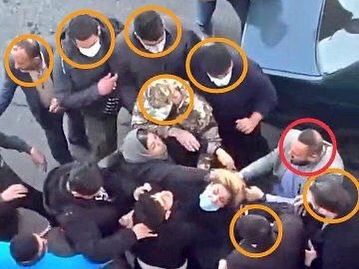Plainclothes Agents In Iran Roam Freely, Angering Citizens

The public is demanding answers after distraught parents of poisoned schoolgirls in Iran were brutally attacked by plainclothes security forces in recent days.

The public is demanding answers after distraught parents of poisoned schoolgirls in Iran were brutally attacked by plainclothes security forces in recent days.
After public outrage and criticism even by some regime loyalists, four men accused of viciously beating a woman in Tehransar were arrested.
Video footage of the attack on the mother outside a girls’ school near the capital Tehran on Wednesday went viral, with demands for answers flooding social media.
The police have denied any involvement in the incident which saw several men surrounding and assaulting the woman who was apparently accusing the government of responsibility for the attacks. One of the men who dragged the woman by the hair has been identified as a Basij militia official by social media users.
It is often difficult to differentiate plainclothes agents from Basij militiamen or members of the public. Plainclothes forces who could be affiliated with any of the many intelligence and military organizations have often been seen working in tandem with pro-government vigilantes, beating and arresting protesters, and even destroying people’s vehicles and breaking shop windows.
Another video posted on social media on Saturday shows plainclothes forces violently arresting two schoolgirls in Karaj, forcing them into a car before driving them away.
While speculation grows as to the perpetrators of the poisonings in the girls’ schools, which began in the religious city of Qom in November and has now reached scores of schools around the country, even ministers have pointed the finger towards the government.
Last week, deputy education minister Younes Panahi said that "It was found that some people wanted all schools, especially girls' schools, to be closed," confirming fears that the regime is cracking down on girls who have been at the forefront of the Women, Life, Freedom movement since September.
"It has been revealed that the chemical compounds used to poison students are not war chemicals, and the poisoned students do not need aggressive treatment, and a large percentage of the chemical agents used are treatable," he told a press conference.
The five months of protests, sparked by the death in custody of Mahsa Amini in September, arrested by the morality police for not wearing her headscarf appropriately, has been supported nationally by schools, images being shared of girls burning pictures of the Supreme Leader, burning headscarves and cutting their hair.
Parents have staged rallies outside education departments in several Iranian cities in protest of the authorities’ failure to address the poisoning attacks. A number of the protesters were reportedly arrested by security forces.
Investigations to find the attacker of the woman outside the school is difficult due to the existence of numerous and parallel organizations, Mohsen Borhani, a criminologist and professor of law at Tehran University said in a tweet after the police’s claim that the man beating the woman outside the school was not one of theirs: “Woe to the nation who does not know which organization is responsible for beating it up!”
In another tweet, Borhani told the authorities that had they not prevented people from taking videos during protests, or forcing owners of CCTVs to delete their footage of the protest, hundreds responsible for attacks similar to the one on the woman outside the Tehransar school would have been identified. He added that authorities did not truly wish to prevent such acts of aggression against the public.
During recent unrest, protesters often noticed certain clothing items and accessories such as baseball caps or crossbody sling bags and shirt tails draped over their trousers or even two watches, one on each wrist, to allow them recognize each other from others on the scene. In one case a protester reported that plainclothes forces were all wearing red t-shirts that day.
In an interview with the Iranian Labour News Agency (ILNA) on January 8, interior Minister Ahmad Vahidi denied that there were any plainclothes forces on the ground and claimed all security forces dealing with protesters were uniformed.
However, protesters claimed plainclothes forces who often moved in groups of four, riding on two motorbikes and carrying teasers and walkie-talkies, even openly carried weapons. In one of the videos from a university in Tehran in November, a plainclothes agent is seen drawing a gun from his sling bag and taking a shot.
Tweet unavailable